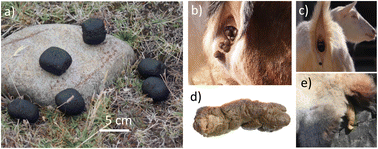Drying dynamics of pellet feces†
Abstract
Pellet feces are generated by a number of animals important to science or agriculture, including mice, rats, goats, and wombats. Understanding the factors that lead to fecal shape may provide a better understanding of animal health and diet. In this combined experimental and theoretical study, we test the hypothesis that pellet feces are formed by drying processes in the intestine. Inspirational to our work is the formation of hexagonal columnar jointings in cooling lava beds, in which the width L of the hexagon scales as L ∼ J−1 where J is the heat flux from the bed. Across 22 species of mammals, we report a transition from cylindrical to pellet feces if fecal water content drops below 0.65. Using a mathematical model that accounts for water intake rate and intestinal dimensions, we show pellet feces length L scales as L ∼ J−2.08 where J is the flux of water absorbed by the intestines. We build a mimic of the mammalian intestine using a corn starch cake drying in an open trough, finding that corn starch pellet length scales with water flux−0.46. The range of exponents does not permit us to conclude that formation of columnar jointings is similar to the formation of pellet feces. Nevertheless, the methods and physical picture shown here may be of use to physicians and veterinarians interested in using feces length as a marker of intestinal health.



 Please wait while we load your content...
Please wait while we load your content...